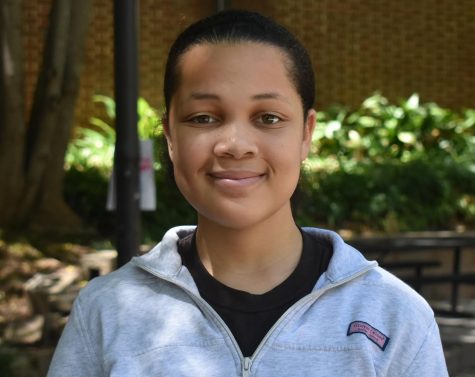De Facto Segregation Persists In AP Classes
Advanced Placement (AP) classes are designed to provide a jump-start on a college education, give students an opportunity to earn college credit and increase students’ chances of college admission and success.
However, many of the classes advertised are not racially diverse, despite the plentiful pros of taking them.
“I feel like there should be more minorities involved in AP classes,” said sophomore Taliyah Holloway, who is African American.
The lack of diversity within AP classes is a common phenomenon at many schools, and it correlates with an achievement gap between both race and class, according to research from The Atlantic Magazine.
At Grady, there are about half as many minorities taking AP classes compared to their white counterparts. Out of the 1,358 students enrolled at Grady, of these 738 take at least one AP class.
According to the school records as of Aug. 14, there were 17 Asians, 212 African Americans, 27 Hispanics, 1 Indian, and 59 students who identify as mixed races, taking AP classes. This is compared to the 422 white students who take AP classes.
The diversity within AP classes has been identified as an issue and something in need of change. Four years ago, former AP coordinator Brandi Sabb started an initiative to help gain and retain minorities within the classes: The AP Initiative. The process has been taken on by Assistant Principal Willie Vincent.
“We audit every transcript for classes for the next year,” Vincent said describing the AP placement system devised to accumulate more minorities in AP classes. “For example, Bria (Vincent referring to the reporter as a hypothetical student) may choose regular 10th-grade lit., but when I’m auditing her transcript, and I see that she’s got a 95, I’m going to put her in Honors Lit. And that’s the same thing that we do with AP.”
This system of collecting students has evolved with the addition of AP Human Geography, which was added in the beginning of the 2016-2017 school year, as a primarily freshman class taught by Christopher Wharton.
“I was motivated to take AP classes in 8th grade because they started a 9th-grade course called ‘AP Human Geography,’” said Holloway. “I wanted the rigor and hard work to prepare me for later on.”
AP classes brought in students like Holloway because they better prepare students for college and helps in the college admissions process.
“I’ve heard that AP classes have had the best teachers and classmates, so it would just be more interesting to take them,” senior Hannah Prausnitz-Weinbaum said, who identifies as a minority as she is a woman and Jewish.
Weinbaum is currently in line to be valedictorian for the class of 2018, and is considering applying to MIT, Tufts, and Vanderbilt University.
“Also, on-level classes at Grady do not offer a challenge, so you really have to take AP if you want a challenge in a certain topic,” Prausnitz-Weinbaum added.
The idea of classes that are harder than what students are expecting is what has lead to the need to increase minority attendance and retention within these classes. Many students don’t believe that they can do well in these classes and that destroys the appeal of the class within its entirety.
“The kids we are trying to target are the kids who would never choose AP on their own,” said Vincent.
The initiative created was to help get minorities into the AP classes and since then, upon placing them into the introductory social studies class, AP Human Geography, the retention rate of minorities has gone up.
“Surprisingly, I see a little more [minorities compared to last year] but maybe like one-third,” sophomore Imani Pittman, who is African American, said about diversity within AP classes.
According to Mr. Vincent, the exact reason why students would take AP classes is the reason behind why many students do not want to take the class, which leads to less diversity. The challenges that go along with taking AP classes, such as the workload and the challenge drive many minorities away from taking the AP classes that their Caucasian counterparts are enrolled in.
“I don’t take more [AP classes] because I felt as though it would be overwhelming and honestly the other AP classes didn’t interest me,” Junior African American Askya Alexander said,“Okay sure I could have taken Calculus or Language [referring to the AP classes], but why put myself through the pressure and all of that when it would’ve been pointless since I would’ve hated the class and it would’ve messed up my GPA.”
Alexander is a senior who takes three AP classes: Statistics, Psychology, and US History. In agreeance Alexander, Gavin Green says that he believes that the classes are too much work and too stressful.
However, many students do see the allure of the AP classes despite the laborious amount of work that goes into the classes.
“I probably would not be able to get into Duke [her dream college] without AP classes,” said sophomore Olivia Weller, who is Caucasian. She is willing to take these.
This would be the driving force behind taking AP classes. Until more minorities begin to take AP classes and recognize benefits of the classes, The AP Initiative will live on.
“The goal is for one day every student to take an AP class,” said Vincent.

Bria Brown is a second year staff member on the Southerner as well as a senior in the Class of 2020. She is currently Photography/Multimedia Editor and...


Cate • Feb 5, 2018 at 8:46 pm
good job Bria! glad to see our stats come to life… and to be in cover photo of this article, lol.
Sherrie Proctor • Jan 25, 2018 at 9:33 am
Nice job with this article Bria! I’m very proud of you and the focus of your work.
Bria Brown • Dec 19, 2017 at 4:52 pm
Wow. That’s so good. More people need to read the hard hitting stories like this.